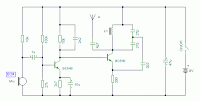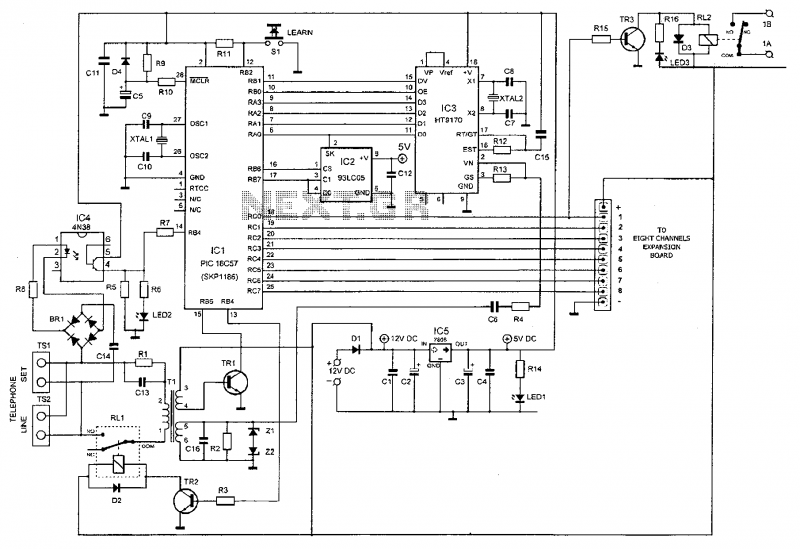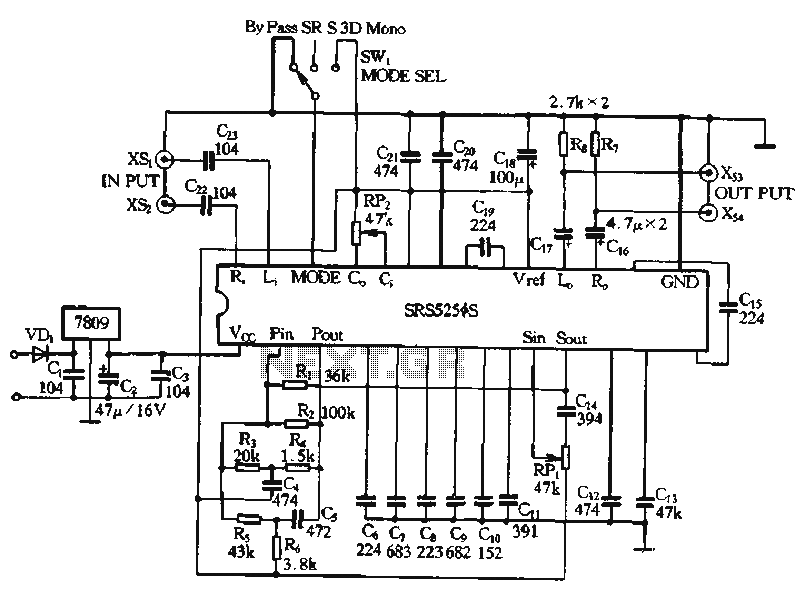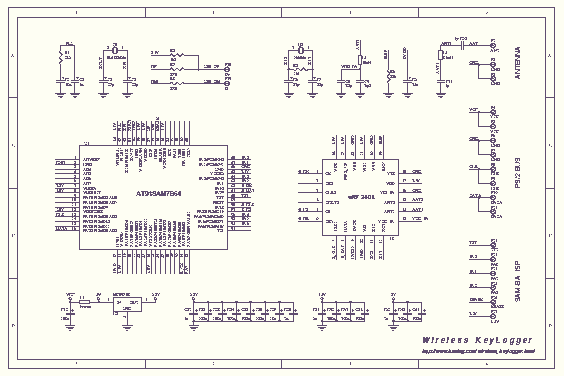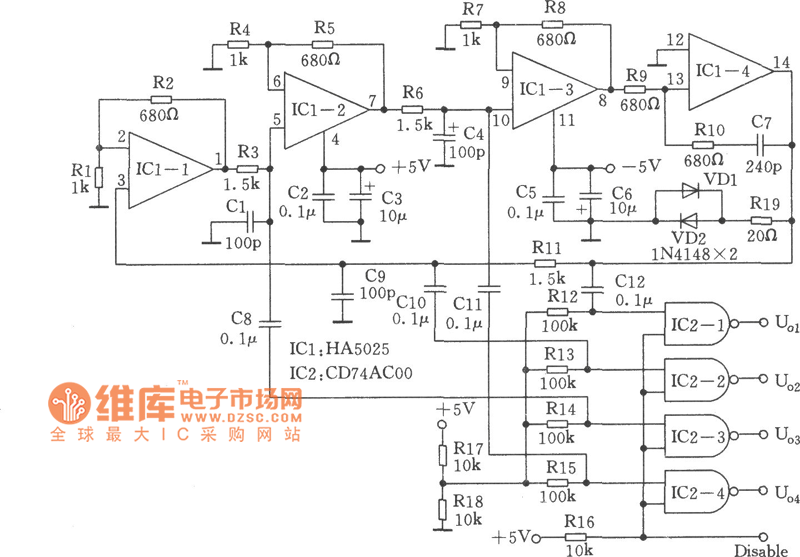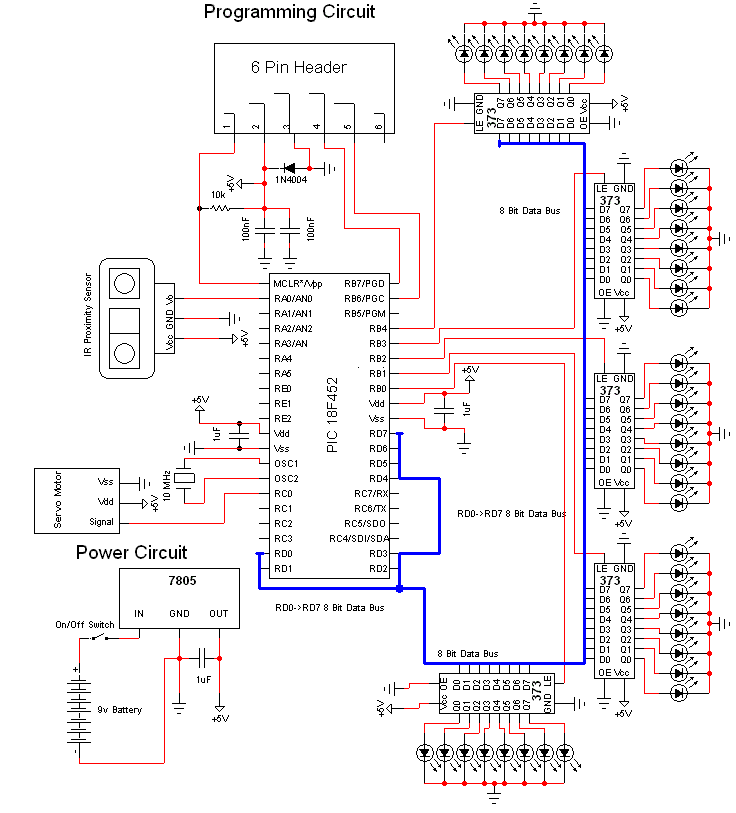
TV audio circuit diagram TDA1521
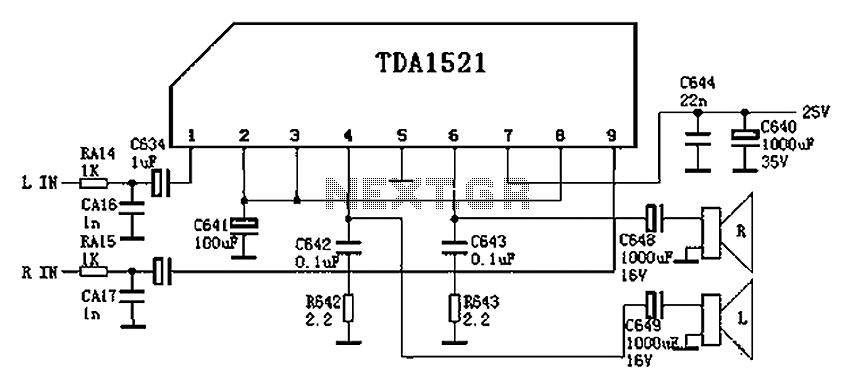
Color is often used in audio circuits like the TDA1521, which is derived from the Changhong C2191 model featuring an OTL two-channel connection. The pin functions and reference voltages for the TDA1521 are as follows: Pin 1: 11V - reverse input 1 (L-channel signal input); Pin 2: 11V - positive input 1; Pin 3: 11V - Reference 1 (0V in OCL connection, 1/2Vcc in OTL connection); Pin 4: 11V - output 1 (L-channel signal output); Pin 5: 0V - negative power supply input (ground connection in OTL); Pin 6: 11V - output 2 (R-channel signal output); Pin 7: 22V - positive power supply input; Pin 8: 11V - positive input 2; Pin 9: 11V - reverse input 2 (R-channel signal input).
The TDA1521 integrated circuit is designed for audio amplification applications, particularly in configurations that utilize an output transformerless (OTL) approach. This amplifier is capable of delivering high-quality audio signals with low distortion, making it suitable for consumer audio equipment. The pinout configuration provides essential connections for both input and output signals, as well as power supply requirements.
Pin 1 serves as the reverse input for the left channel, allowing the circuit to receive audio signals. Pin 2 acts as the positive input for the left channel, where the audio signal is fed into the amplifier. Pin 3 is critical for reference voltage management, ensuring the amplifier operates within the correct voltage range depending on the connection type—either OCL (output capacitor-less) or OTL.
The output for the left channel is provided at Pin 4, which delivers the amplified signal to the speakers. Pin 5 connects to the ground, serving as the negative power supply input in OTL configurations, which is essential for circuit stability and performance.
For the right channel, Pin 6 provides the output signal, while Pin 7 connects to a 22V positive power supply, which is necessary for proper amplifier operation. Pins 8 and 9 serve similar functions as their left channel counterparts, with Pin 8 being the positive input for the right channel and Pin 9 acting as the reverse input.
Overall, the TDA1521 is a versatile audio amplifier that can be effectively utilized in various audio applications, delivering reliable performance and high-quality sound reproduction. Proper understanding of its pin configuration and voltage requirements is crucial for effective circuit design and implementation. Colour is often used as shown in audio circuit (TDA1521), the circuit is taken from Changhong C2191, the OTL two-channel connection. TDA1521 pin functions and reference voltage : Pin 1: 11V-- reverse input 1 (L-channel signal input) Pin 2: 11V-- positive input 1 3 feet: 11V-- Reference 1 (when the OCL connection to 0V, when the OTL connection is 1/2Vcc) 4 feet: 11V-- output 1 (L-channel signal output) 5 feet: 0V-- negative power supply input (connection to ground when OTL) 6 feet: 11V-- output 2 (R channel signal output) Pin 7: 22V-- positive power supply input 8 feet: 11V-- positive input 2 9-pin: 11V-- reverse input 2 (R-channel signal input)
The TDA1521 integrated circuit is designed for audio amplification applications, particularly in configurations that utilize an output transformerless (OTL) approach. This amplifier is capable of delivering high-quality audio signals with low distortion, making it suitable for consumer audio equipment. The pinout configuration provides essential connections for both input and output signals, as well as power supply requirements.
Pin 1 serves as the reverse input for the left channel, allowing the circuit to receive audio signals. Pin 2 acts as the positive input for the left channel, where the audio signal is fed into the amplifier. Pin 3 is critical for reference voltage management, ensuring the amplifier operates within the correct voltage range depending on the connection type—either OCL (output capacitor-less) or OTL.
The output for the left channel is provided at Pin 4, which delivers the amplified signal to the speakers. Pin 5 connects to the ground, serving as the negative power supply input in OTL configurations, which is essential for circuit stability and performance.
For the right channel, Pin 6 provides the output signal, while Pin 7 connects to a 22V positive power supply, which is necessary for proper amplifier operation. Pins 8 and 9 serve similar functions as their left channel counterparts, with Pin 8 being the positive input for the right channel and Pin 9 acting as the reverse input.
Overall, the TDA1521 is a versatile audio amplifier that can be effectively utilized in various audio applications, delivering reliable performance and high-quality sound reproduction. Proper understanding of its pin configuration and voltage requirements is crucial for effective circuit design and implementation. Colour is often used as shown in audio circuit (TDA1521), the circuit is taken from Changhong C2191, the OTL two-channel connection. TDA1521 pin functions and reference voltage : Pin 1: 11V-- reverse input 1 (L-channel signal input) Pin 2: 11V-- positive input 1 3 feet: 11V-- Reference 1 (when the OCL connection to 0V, when the OTL connection is 1/2Vcc) 4 feet: 11V-- output 1 (L-channel signal output) 5 feet: 0V-- negative power supply input (connection to ground when OTL) 6 feet: 11V-- output 2 (R channel signal output) Pin 7: 22V-- positive power supply input 8 feet: 11V-- positive input 2 9-pin: 11V-- reverse input 2 (R-channel signal input)
